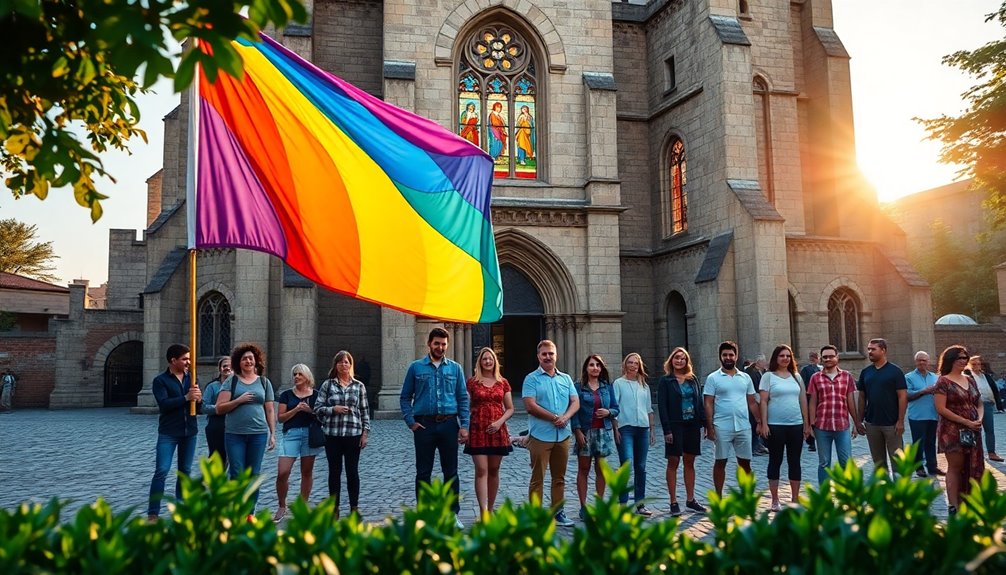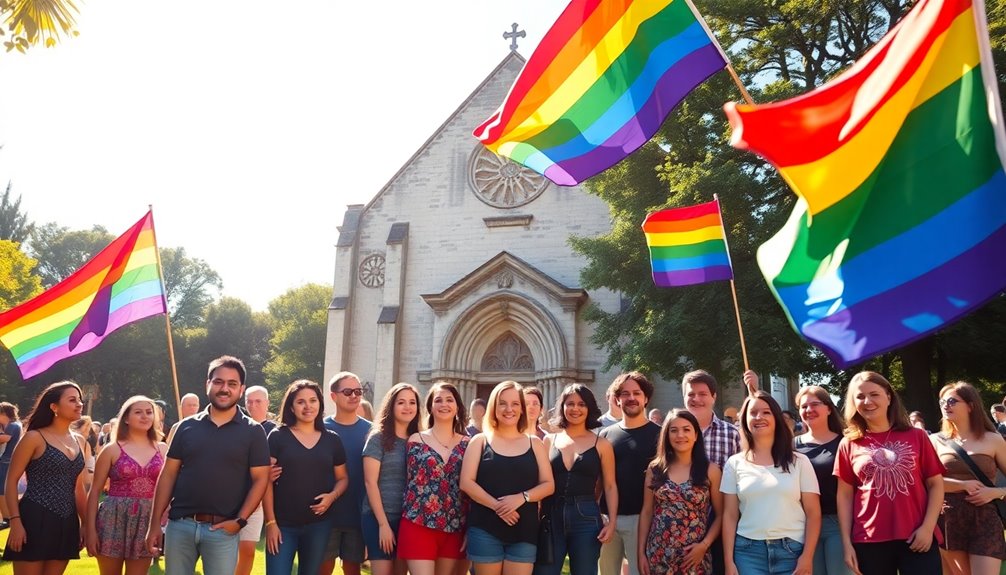Being gay isn't inherently a sin. Many contemporary interpretations of religious texts focus on love and acceptance rather than condemnation. The verses often cited against homosexuality were aimed at specific practices, not loving relationships. Cultural norms of ancient societies deeply influenced these texts, frequently misinterpreted in modern contexts. Understanding these perspectives can help you reconcile faith with sexual orientation. Numerous faith-based support networks are available, promoting inclusivity and acceptance for LGBTQ+ individuals. If you're curious about how interpretations have evolved over time, you'll find compelling insights on this topic ahead.
Key Takeaways
- Many biblical interpretations focus on specific exploitative behaviors rather than condemning loving same-sex relationships.
- Historical context reveals that early Christians did not have modern concepts of sexual orientation.
- Contemporary theologians emphasize love and inclusion as central to Jesus' teachings, challenging traditional views on sin.
- Faith-based support networks foster understanding and acceptance for LGBTQ+ individuals within religious communities.
- Evolving perspectives in Christianity increasingly recognize and affirm LGBTQ+ relationships as expressions of love rather than sin.
Introduction

The question of whether being gay is a sin sparks intense debate across various religious communities. You'll find that interpretations vary widely, with some groups firmly believing that traditional biblical teachings condemn homosexuality.
Others argue that love, especially in committed relationships, shouldn't be labeled as sinful. These differing views often lead to discussions about LGBTQ+ issues, highlighting how cultural beliefs shape the concept of sin.
Many biblical passages often cited against homosexuality focus on specific practices rather than consensual same-sex relationships. This raises important questions about their relevance in today's conversations about sexuality.
Historical context shows that societal views on sexuality have evolved, prompting many Christians to reconsider traditional interpretations of scripture regarding LGBTQ+ identities.
It's crucial to recognize that numerous LGBTQ+ individuals reconcile their sexual orientation with their faith. They assert that God loves all people, regardless of sexuality, and emphasize the significance of having a personal relationship with the divine.
In this ongoing debate, you'll see that perspectives are deeply rooted in individual beliefs and experiences, making this a complex and sensitive topic within the wider religious landscape.
Biblical Textual Analysis

When you look at primary and secondary Bible references, it's important to consider the context and intent behind the texts.
Many passages often cited as condemning same-sex relationships actually focus on specific practices rather than loving partnerships.
Primary Bible References
In examining primary Bible references related to same-sex relationships, it's essential to consider both the text and the context in which it was written. The Bible says in Leviticus 18:22 that men shouldn't lie with men as they do with women, but this verse focuses on specific practices and doesn't address loving partnerships.
Similarly, Romans 1:26-27 speaks to exploitative sexual behavior rather than consensual relationships. The narrative of Sodom and Gomorrah is often cited, yet this story revolves around sexual violence and inhospitality rather than same-sex relationships.
Furthermore, the New Testament verses like 1 Corinthians 6:9-10 critique sexual immorality but don't target loving same-sex partnerships explicitly. Understanding that 1st-century culture lacked the same concepts of sexual orientation we've today is vital.
This historical context suggests that many contemporary interpretations may misrepresent the original intent of biblical texts. Hermeneutical approaches highlight the importance of considering historical, cultural, and linguistic contexts, allowing for a more nuanced understanding of what the Bible says about sexuality.
Secondary Bible References
Examining secondary Bible references can further illuminate the discussion around same-sex relationships. Key verses like Romans 1:26-27 and 1 Corinthians 6:9-10 often come up in these debates. However, it's important to realize that these verses primarily address specific practices rather than consensual same-sex relationships.
Romans 1 focuses on idolatry and self-centered lust, which suggests that the text's condemnation isn't aimed at loving same-sex connections. Additionally, 1 Timothy 1:10 lists "men who practice homosexuality" alongside various vices, yet this doesn't capture the essence of contemporary loving same-sex relationships.
When you look at the narratives of Sodom and Gomorrah, it's clear they focus on sexual violence rather than consensual acts, indicating a common misinterpretation of these texts. Understanding the cultural and historical contexts of biblical authors is crucial for interpreting these passages.
Many verses don't directly address modern concepts of sexual orientation, and relying solely on secondary Bible references without considering their context might lead to misunderstandings. By approaching these texts with an open mind, you can gain a more nuanced perspective on the conversation surrounding homosexuality and faith.
Ancient Societal Norms on Sexuality

Ancient societies had nuanced views on sexuality that diverged significantly from today's binary understandings. In these cultures, sexual norms often revolved around procreation and lineage, meaning that same-sex relationships were typically viewed through the lens of power dynamics rather than love or partnership.
For instance, in the Greco-Roman world, people understood gender and sexuality in complex ways that don't fit neatly into modern categories.
When you consider narratives like that of Sodom and Gomorrah, it's clear that the primary focus was on sexual violence and inhospitality, not consensual same-sex relationships. Similarly, Levitical laws regarding sexual practices reflected specific health and societal concerns of that era, rather than an outright condemnation of same-sex partnerships as we might interpret them today.
Furthermore, early Christians lacked an understanding of sexual orientation as a distinct identity, which shaped their interpretations and responses to same-sex relationships.
Thus, when examining ancient societies, it's essential to recognize that their views on sexuality weren't only multifaceted but also rooted in entirely different social and cultural contexts than those we face today.
Cultural Context of Biblical Texts

Understanding the cultural context of biblical texts is crucial for grasping their interpretations regarding sexuality. Ancient societies had distinct views on sexual relationships, often emphasizing power dynamics and exploitation rather than consensual same-sex partnerships. Many biblical passages often cited against homosexuality actually address specific practices like sexual violence or idolatry, not committed same-sex relationships.
Take the narratives of Sodom and Gomorrah, frequently misinterpreted as a condemnation of homosexuality. These stories center more on themes of hospitality and the violent intentions of the inhabitants than on sexual orientation.
Similarly, Levitical laws concerning sexual behavior were shaped by societal concerns about health, lineage, and cultural purity, rather than a comprehensive moral framework we might apply today.
Moreover, the absence of clear categories for sexual orientation in the 1st century suggests that contemporary interpretations of same-sex relationships mightn't align with the original intentions of these biblical texts.
Debate on Biblical Interpretation

When you look at the Levitical laws, it's crucial to consider the cultural context in which they were written.
Many misconceptions arise from reading these texts without understanding their true intentions and historical background.
Debunk Common Misconceptions
Many people hold misconceptions about what the Bible says regarding homosexuality, often relying on selective interpretations of scripture. When you look closely, many biblical passages cited against LGBTQ+ people often address specific practices or cultural concerns rather than consensual same-sex relationships.
For instance, the stories of Sodom and Gomorrah focus more on sexual violence and inhospitality than on condemning same-sex love, indicating a common misreading of these texts.
Historical context is crucial, too. Early Christians didn't understand sexual orientation in the way we do today. This suggests you should reconsider modern interpretations based on evolving knowledge.
Many contemporary theologians argue that Jesus' teachings emphasize love and inclusion, challenging traditional views that label same-sex relationships as sinful.
Studies reveal that interpretations condemning homosexuality often stem from selective readings of the Bible, neglecting the overarching themes of love and acceptance.
By approaching scripture with a holistic perspective, you can begin to see that the focus should be on fostering compassion and understanding rather than judgment.
It's time to debunk these misconceptions and embrace a more inclusive interpretation of faith.
Interpretation of Levitical Laws
Two key verses in Leviticus—18:22 and 20:13—are often used to argue against same-sex relationships, but their implications are far more complex. Many scholars suggest the Levitical laws were shaped by ancient societal norms, primarily focusing on health and lineage rather than consensual love.
The cultural context reveals concerns about ritual purity and maintaining societal order, which doesn't align with our modern understanding of sexual orientation and committed relationships.
Interpretations of these laws vary widely. Contemporary theologians increasingly argue that the Levitical injunctions don't apply to loving same-sex relationships as we understand them today.
Historical insights into sexual practices in the ancient Near East, including pederasty and cultic rituals, are essential for grasping the intent behind these prohibitions.
A growing number of faith communities advocate for re-evaluating the Levitical laws in light of contemporary views on sexuality. They emphasize love and mutual respect over rigid adherence to ancient texts.
Ultimately, when interpreting Levitical laws, context matters. You might find that these ancient injunctions don't reflect the values of love and inclusivity that many hold dear today.
Faith-Based Support Networks

Faith-based support networks can be a vital resource for you as you reflect on your spirituality and sexual identity.
These organizations foster inclusive church practices that celebrate diversity and promote acceptance, allowing you to grow in a safe environment.
Engaging with these communities can help challenge harmful beliefs and lead to a deeper understanding of your faith.
Individual Reflection and Growth
Support networks rooted in faith offer LGBTQ+ individuals a vital space for personal reflection and growth. Within these supportive environments, you can explore your identity while reconciling your sexual orientation with your spiritual beliefs. These networks emphasize love and acceptance, allowing you to feel safe and free from the fear of condemnation.
Many queer Christians report finding affirmation in faith-based support networks, which encourage self-acceptance and a deeper relationship with God. By participating in these communities, you might discover that your mental well-being improves significantly, as the stigma often faced in society begins to diminish.
Programs like Confidently Queer prioritize personal connections with God, helping you address intimate questions about divine acceptance, fostering a sense of belonging. The shift away from rigid doctrinal interpretations toward a more inclusive understanding reflects an evolving perspective that values individual reflection and growth.
As you engage with these faith-based support networks, you're likely to find the encouragement needed to embrace your true self, cultivating a deeper spiritual experience that enriches your journey. Embracing this supportive environment can empower you to grow in both faith and identity.
Inclusive Church Practices
Inclusive church practices create welcoming environments where LGBTQ+ individuals can express their identities without fear of judgment. These practices prioritize love, acceptance, and mutual respect, fostering communities that uplift and support everyone.
Many churches have established support networks that offer resources, counseling, and community engagement specifically designed for LGBTQ+ members, affirming their rightful place within the faith.
The development of affirming theology plays a crucial role in this movement. Through workshops, discussion groups, and educational resources, congregations reinterpret scripture to honor LGBTQ+ relationships and experiences. This not only enriches the understanding of faith but also builds stronger bonds within the community.
Research shows that congregations embracing inclusivity report higher levels of mental well-being and community satisfaction among their LGBTQ+ members.
When you participate in an inclusive church, you're not just finding spiritual nourishment; you're also contributing to a culture that advocates for justice and equality.
Numerous faith-based organizations actively support the rights of LGBTQ+ individuals, ensuring that their voices are heard both within the church and society at large.
Final Thoughts on Interpretation

When examining the interpretation of biblical texts in relation to same-sex relationships, it's essential to consider the historical and cultural contexts that shaped them. Many verses often cited against homosexuality focus on specific practices rather than consensual relationships. This highlights the importance of hermeneutics, which encourages a holistic approach to scripture. Isolating verses can lead to misinterpretation and misunderstandings of broader biblical themes like love and acceptance.
As church beliefs evolve, it's evident that re-evaluating interpretations in light of new information and personal experiences can foster a more inclusive understanding of LGBTQ+ identities within Christianity. Many LGBTQ+ individuals assert their sexual orientation doesn't conflict with their faith, directly challenging traditional views labeling being gay as sinful.
The growing recognition among millions of Christians today of God's work in LGBTQ+ relationships calls for faith communities to reconsider their interpretations. By embracing a compassionate and inclusive approach, you can contribute to a more accepting environment that honors both scripture and the lived experiences of LGBTQ+ individuals.
Ultimately, interpreting scripture through the lens of love and acceptance paves the way for deeper understanding and unity within the faith community.
Additional Resources

Exploring additional resources can greatly enhance your understanding of LGBTQ+ interpretations of scripture and foster a more accepting viewpoint within faith communities.
Cheryl B. Anderson's 2009 work on inclusive biblical interpretation offers valuable insights that affirm LGBTQ+ identities, challenging traditional views.
Karen R. Keen's 2018 exploration of same-sex relationships in the New Testament provides a compelling argument for reinterpretation grounded in love and commitment, aligning with core biblical teachings.
Matthew Vines, in his 2014 book, presents a strong biblical case for same-sex relationships, emphasizing the importance of context and the nature of love as described in scripture.
James V. Brownson's 2013 work reframes the church's debate on sexuality, advocating for a perspective that honors diverse relationships within a Christian framework.
Additionally, Elizabeth M. Edman's 2016 insights encourage faith communities to embrace inclusivity and foster acceptance, revitalizing Christianity through the experiences of LGBTQ+ individuals.
Frequently Asked Questions
Was Jesus Gay or Straight?
You might wonder about Jesus' sexual orientation. The Gospels don't provide specific details about his romantic life, so it's hard to label him as gay or straight.
Close relationships with male disciples can be seen as expressions of deep friendship typical of that time.
Jesus focused on love, acceptance, and compassion, which transcends modern sexual orientation labels.
Ultimately, understanding his life and teachings requires looking beyond contemporary views to appreciate the historical context.
Is It a Sin to Love the Same Gender?
Loving someone of the same gender isn't inherently a sin. Many believe that love, regardless of gender, reflects the core teachings of compassion and acceptance found in spiritual texts.
You might find that interpretations of love vary widely among different faith communities. Ultimately, it's important to focus on the quality of your relationships and the love you share, rather than societal labels or outdated beliefs that don't align with modern understandings of love and commitment.
What Religion Supports Homosexuality?
If you're looking for religions that support homosexuality, you've got several options.
Progressive Christian denominations like the United Church of Christ and the Episcopal Church openly affirm LGBTQ+ rights.
Unitarian Universalism embraces inclusivity, while many branches of Buddhism and Hinduism recognize diverse sexual orientations.
Additionally, Reform and Conservative Judaism have made significant strides in LGBTQ+ acceptance.
The Metropolitan Community Church specifically caters to the LGBTQ+ community, promoting a theology of love and acceptance.










